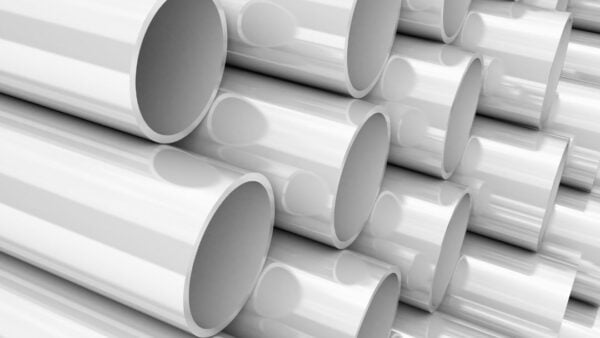In construction, it is a binder, a chemical used to bind and harden various materials into a single unit. Sand and gravel (aggregate) are typically used in conjunction with cement rather than as the primary binding agent. Cement combined with fine aggregate is used to make mortar for masonry, and cement mixed with sand and gravel is used to make concrete. As the second-most-utilized resource globally, concrete ranks as the most commonly used substance on Earth.
Hydraulic and non-hydraulic best cement in India is extensively employed in the construction industry; they are classed based on their capacity to set in water (see hydraulic and non-hydraulic lime plaster).
When the non-hydraulic cement is exposed to moisture or submerged in water, it does not harden and will not set. After it has been set, it becomes resistant to chemical attacks.
The chemical reaction between the dry materials and the water causes hydraulic cement (for example, Portland cement) to set and become adhesive. Mineral hydrates are formed due to the chemical reaction, and because they are not highly water-soluble, they are quite durable in water and resistant to chemical attack. It allows for setting in damp environments or submerged in a while and further protection against the hardened material’s chemical attacks. Hydraulic cement was discovered by ancient Romans who mixed volcanic ash (pozzolana) with lime to create today’s chemical process (calcium oxide).
Nowadays, organic polymers are sometimes utilized as cement in concrete, which is a relatively new development.
The world’s annual production is approximately four billion tonnes, with over half of that coming from China. The early calcination reaction is responsible for around 4% of world CO2 emissions in the cement company in India manufacturing process.
There are two emissions.
- The whole process is responsible for around 8% of worldwide CO2 emissions.
- The process occurs in a cement kiln heated by radiant heat transfer using coal or petroleum coke, which emits CO2 because of the intense flame needed to heat the kiln.
Consequently, the cement industry contributes to global climate change emissions.
The cement of the twenty-first century
Modern hydraulic development began around the time of the beginning of the Industrial Revolution (about 1800) and was motivated by three primary requirements:
- Hydraulic india best cement, is good for completing brick buildings in damp conditions.
- Hydraulic mortars for use in the masonry construction of harbor works and other structures that come into touch with seawater.
- Research and development of concretes with high strength
- Modern cement is frequently made of Portland cement or Portland cement blends, although other types of cement are also used in the industry.
India’s Top Ten Cement Brands
With approximately 151.2 million tonnes per year, India is the world’s second-largest cement producer behind China. As a result, India has attracted several of the world’s best and brightest cement businesses to the country.
There are around 185 big cement plants in India, with 77 located in Rajasthan, Tamil Nadu, and Andhra Pradesh. Cement is a crucial building material for any home. The best cement brands are sought after by the major small house construction businesses since the quality of the cement determines the long-term viability of the structure.
It produced in the list of the best cement firms in India. Select any brand since they are well-known in the cement manufacturing sector and do not compromise on the quality of their cement because they are expanding with time.
The most crucial consideration is your budget; you can choose from any reputable cement companies mentioned below. Quality-wise, all of the cement on our list are excellent, but you must choose the finest one for your needs based on your budget and the available brands in your area. All publicly-traded cement companies have similar pricing structures and their quality.
Rank of Cement Company Market Capitalization (Rs. Cr.)
- UltraTech Cement 219524.24 Cr. 36.828 1 UltraTech Cement 219524.24 Cr. 36.828
- Shree Cements 100805.64 crores (Rs. 16.911 crores)
- Ambuja Cements 81014.33 Cr. 13.591 Cr. 3 Ambuja Cements 81014.33 Cr.
- ACC 44543.14 Cr. 7.473 ACC 44543.14 Cr.
- Dalmia Bharat 41627.1 crores 6.983 crores
- Ramco Cements 26422.03 Cr. 4.433 Cr. 6 Ramco Cements 26422.03 Cr.
- J. K. Cement 24014.97 Cr. 4.029 24014.97 Cr. 4.029
- Eighth, JK Lakshmi Cements, 8381.05.00 Cr. 1.4006.
- India Cements 6101.88 crore rupees 1.024
- Heidelberg Cements, 5881.74 CR 0.9871
Here are the top 10 Best Cement in India:
1. UltraTech Cement.
UltraTech Cement Ltd. is headquartered in Bangalore, India. As a result, it is a major cement producer worldwide. The corporation created the UltraTech Cement trademark in 1983 when it first entered the cement sector. This organization has its headquarters in Mumbai, India’s financial hub. It is among the top cement companies in india.
Ultratech is the largest of India’s top five cement businesses, with a market capitalization of $1 billion. Ultra Tech is a subsidiary of Grasim Industries, a component of the Aditya Birla Group of companies.
- The company was founded in 1987.
- Mumbai serves as the corporate headquarters.
- • Profit after tax: Rs. 42,124.00 Cr.
- • Market capitalization (in crores rupees): Rs. 191,604 crores
2. Ambuja Cement.
As a cement manufacturing behemoth in India, Ambuja Cements Limited (previously Gujarat Ambuja Cement Limited) has been a fixture in the country’s cement business for more than three decades. Ambuja Cement was established in 1983 and headquarters in Mumbai, Maharashtra. The management controls of Ambuja Cements were purchased by the Swiss-based global cement corporation Holcim in 2006. It is one of the top cement company in india.
Only a small percentage of the population knows that the company was originally called Gujarat Ambuja Cement Ltd. Its yearly revenue exceeds 27 million metric tonnes. The cement produced by Ambuja Cement is of exceptional quality, thanks to the advanced techniques and equipment used in its production. Apart from receiving numerous accolades for the quality of their cement, they have also been recognized for their commitment to environmental conservation, making them one of the most profitable and innovative cement companies in the country. Instead of having a manufacturing facility in several regions across India, they are located in Mumbai.
- The company was founded in 1983.
- Mumbai serves as the corporate headquarters.
- Profit after tax: Rs. 24,148.00 Cr.
- Market capitalization (in rupees): Rs. 57,484 crores
3. ACC Cement
Associated Cement Companies Limited (ACC) is a major cement producer in India. Associated Cement Enterprises Limited includes FE Dinshaw, Killick Nixon, Khataus, Tata, and other businesses. The Association of Cement Manufacturers (ACC) owns and operates 17 modern cement-producing plants. It is the first cement manufacturer to make environmental protection a part of its corporate mission. The company has 12 manufacturing facilities in India, where it manufactures high-quality cement created with the latest technology. It is know n as the best cement brands in india.
- Profit after tax: Rs. 9640.00 Cr.
- Market capitalization (in rupees): Rs. 33,569.00 crores
4. Shree Cement
As a result, the cement price is very competitive and appealing to the consumer; it has a high level of quality and can be negotiated with the builder of your home. According to sales, Shree Cement Ltd is the tenth-largest cement manufacturer globally. The Kolkata-based Bangur family launched the firm in 1979. In 1985, the company built its first cement plant, which had an installed capacity of 0.6 million tonnes per annum. 29.30 million tonnes per year is the company’s total cement production.
- The company was founded in 1970.
- Kolkata, India, is the headquarters.
- Profit after tax: Rs. 12,868.00 Cr.
- Market capitalization (in rupees): Rs. 99,949.00 crores
5. Birla Cement
Cement manufacturing began in 1918 with the establishment of the company.Birla Cement is one of the world’s largest cement producers.
- The company was founded in 1996.
- Mumbai serves as the corporate headquarters.
- Rs. 6,915 crores in net profit
- Market capitalization (in rupees): Rs. 4,500.96 crores
6. J.K. Cement
J.K. Cement began operations in 1975 with the establishment of its first manufacturing facility in Rajasthan. Cement J.K. has an in-house staff of talented and professional individuals dedicated to delivering high-quality cement to its customers.
However, it now has multiple plants throughout India, providing cement to all of the country’s consumers while earning the trust of the Indian public and maintaining its fifth-place ranking.
In addition to cement manufacturing and distribution, the J. K. Cement Company also manufactures and distributes cement-based goods. Indian white cement and wall putty manufacturer, the company ranks second in terms of production capacity.
- The company was founded in 1975.
- Kanpur is the administrative center.
- Profit after tax: Rs. 5,801.00 Cr.
- Market capitalization (in rupees): Rs. 22,599.00 crores
7. Binani Cement
The organization has received certifications in ISO:9001, ISO:14001, and OHSAS18001. The company was founded in 1996.
- Mumbai serves as the corporate headquarters.
- Market capitalization (in rupees): Rs. 6,660.00 crore
8. Jaypee Cement
The Jaypee Group is an Indian conglomerate with headquarters in Noida, India, worldwide operations. Infrastructural conglomerate Jaiprakash Gaur formed Jaypee Cement, a well-diversified infrastructure conglomerate with interests ranging from design and construction to cement to real estate to the hotel business to expressways to information technology to sports and education (non-profit).
A number of the group’s cement factories are located in the Satna Cluster (M.P.), home to some of India’s most rapidly expanding cement output.
Jaypee Cement, a particular combination of Portland cement and Pozzolana Cement manufactured by the firm, is marketed under the brand name Jaypee Cement (PPC).
• Market capitalization (in rupees): Rs. 848.93 crores
9. Dalmia Cement.
Dalmia Cement is a cement manufacturing company based in India. This Cement brand, founded by the well-known industrialist Jaidayal Dalmia, is the ninth-largest cement firm in India in terms of installed production capacity.
Dalmia Bharat Group is a conglomerate that operates in sugar, thermal energy, and other industries. Avenida Properties Ltd and DCB Power Ventures Ltd are two of the company’s subsidiaries.
Dalmia Cement (Bharat) Limited, founded in 1939, is the ancestor of the Dalmia Group. In light of the Dalmia-Jain Group’s dissolution, it is important to note that.
- The company was founded in 1939.
- The headquarters are in New Delhi.
- Total assets: Rs. 9,615.00 crores.
- Market capitalization (in rupees): Rs. 27,592.00 crores
- India Cements is ranked tenth.
- India Cements Limited is a cement producing firm based in the Indian state of Rajasthan.
- Market capitalization (in rupees): Rs. 5,341.00 crores
- Portland cement is a type of cement produced in Portland, Oregon.
10. India Cements
A cement producing business in India, India Cements Limited, appears on the number 10. It is on 10th number as numbering.
Thalaiyuthu, Tamil Nadu, was the first factory to be set up in 1949 after its foundation was established in 1946. Tamil Nadu, Andhra Pradesh, Telangana and Andhra Pradesh, Rajasthan, and two grinding units each with a capacity of 15.5 million tonnes per year make up the company’s seven integrated cement plants.
- Incorporation date in 1946
- Tamilnadu has its headquarters in Chennai.
Other types of cement
Pozzolan-lime cement is a combination of pulverized pozzolan and lime used in the construction industry. These are the types of cement that the Romans utilized, and they can still be seen in surviving Roman structures such as the Pantheon in the city of Rome. Even though they build strength slowly, their ultimate strength might be extremely high. The hydration products that give strength to Portland cement are nearly identical to those found in Portland cement.
Ground granulated blast-furnace slag does not have hydraulic properties; instead, it must be “activated” by adding alkalis, the most cost-effective of which is lime. In terms of their qualities, they are identical to pozzolan lime cement. Only granulated slag can be used as a cement component since it is so finely ground.
Environmental Consequences
The making of cement impacts the environment at every stage of the process. Dust, gases, noise, and vibration emissions from machinery and quarry blasting are examples of airborne pollution. Quarrying also causes damage to the environment by destroying natural habitats. Equipment to decrease dust emissions during the quarrying and cement manufacturing processes is widely employed, and equipment to capture and separate exhaust gases is becoming increasingly popular as time goes on. After quarries have been closed down, environmental conservation includes re-integrating them into the countryside by restoring them to their natural state or re-establishing farming operations on their former sites.Cement has a variety of applications.
The following are the various applications of cement in construction projects:
1. To make cement mortar from scratch
Cement mortar is similar to a paste made by adding a specific amount of water to a mixture of cement and sand to form a paste. In this instance, cement is referred to as the matrix, and sand is referred to as the adulterant. We all know that cement has excellent binding capabilities. While various binding materials are available, cement is the most commonly utilized because of its great strength and water resistance.
2. A method of making ready-mixed cement concrete for use in building.
In construction, cement concrete is a prominent material widely used due to its excellent structural qualities. It contains the following ingredients: cement, fine aggregate, coarse aggregate, and water in the proportions stated above. Preparation of concrete is typically carried out with standard Portland cement. Various cement, such as rapid hardening cement and high alumina cement, have been discovered in unique applications or under specific conditions.
3. To construct structures that are fire and thermal resistant.
High alumina cement is a more appropriate material for use in concrete production for structures in high-temperature zones.
4. To design hydrographic and frost resistant structures.
Concrete with cement as a binding element is used in most hydrographic structures around the world. The constructions created in water or touch with water should be particularly sturdy against moisture, and it should be watertight.
5. To develop chemical resistant structures
In chemical businesses, numerous chemicals are housed, and they may damage the structure if sufficient resistance is not there. Acid-resistant cement is an excellent choice in this situation, as is sewage-carrying buildings and other structures built in harsh coastal environments. Sulphate-resistant cement can be helpful. It can be used as filler in grout Grouting is a process used to reinforce foundations and other structural components by filling cracks, splits, and gaps. Grouted concrete is typically made of Portland cement and water mixed with fine sand. As a result of its tiny particle size, microfine cement can flow into extremely small and deep cracks in a short period.
6. To create Cement concrete highways
Cement concrete roads are more famous than high-grade roads stronger than any other form of road. They are also referred to as hard pavements because of their unyielding character. C.C. roads have a long-life span even without adequate maintenance. Load wise furthermore they are significantly capable than all other varieties.
7. To make precast members
Many precast members are constructed utilizing cement as binding material. Cement concrete pipes are frequently utilized as drains, pipes under culverts etc.
8. For attractive concrete construction
Nowadays, cement is available in different colors. Some of the coloring ingredients are iron oxide, red or brown, cobalt, blue, etc.
Read More: Best Garner




